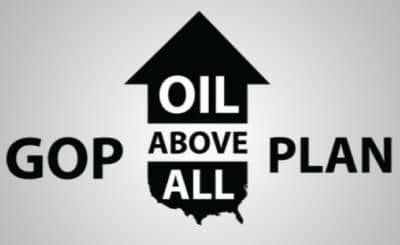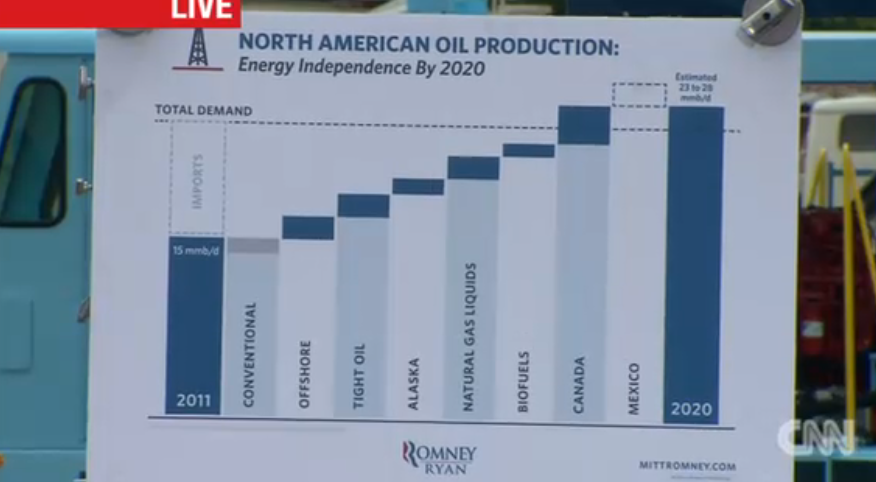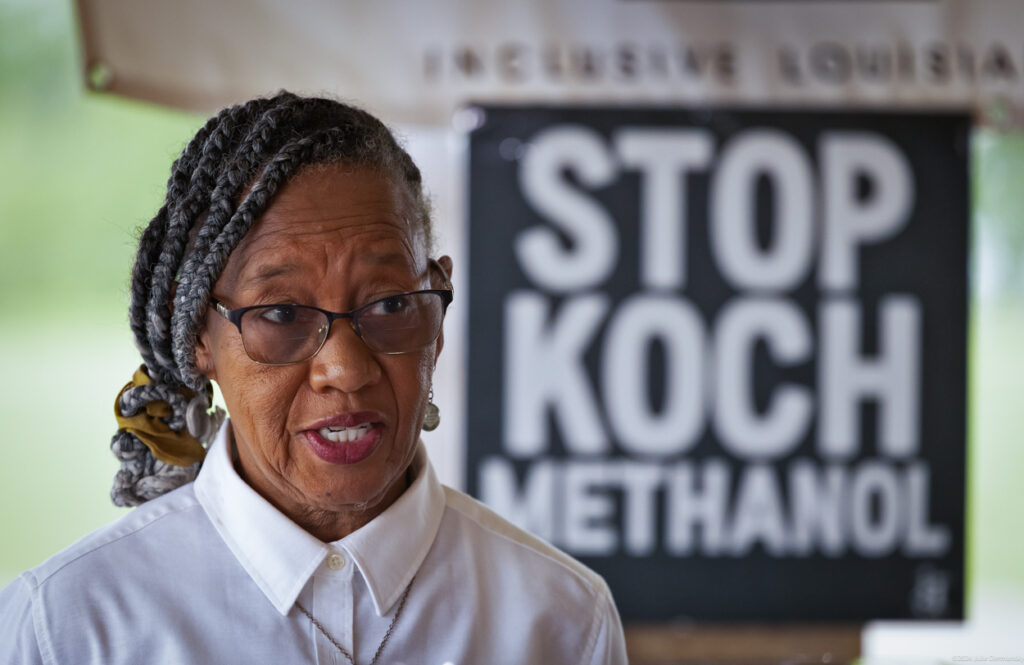Last Thursday, Mitt Romney presented his “oil above all” energy plan, in which he promised “North American energy independence” by 2020. Far from comprehensive, the plan echoes the familiar “Drill, Baby, Drill” mantra from the 2008 presidential campaign, and offers no energy strategy beyond increasing domestic production of oil and gas, and increased access to Canadian tar sands crude.
Proving his devotion to “oil above all” was the graph that the presidential hopeful presented while unveiling his plan to a “modest crowd” in New Mexico. As far as graphics go, it’s confused and misleading, so let me walk you through it in case you missed CNN‘s live coverage.
Though it’s titled “North American Oil Production: Energy Independence by 2020,” the demand line represents only the United States’ oil needs. Hey, at least the Romney team doesn’t anticipate our oil consumption to rise over the next eight years.
The bar on the left represents the roughly 15 million barrels per day that the U.S. produces, and the roughly 7 million barrels per day that we import.
Each bar to the right represents a theoretical production or import “gain” that could be achieved by 2020 under Romney’s plan. Another 2 million barrels per day from unrestricted offshore drilling. Another 2 million barrels per day from “tight oil” or shale oil that can only be recovered through fracking. Another 1 million barrels per day from unrestricted drilling in Alaska. Increased production of natural gas liquids and biofuels, a head scratcher since this graph is supposedly about “oil production.” Then, the tentative imports from Canada and, to a lesser and less certain degree, Mexico.
This “oil above all” plan was announced just two days after Romney attended an industry fundraiser that helped to raise $7 million for his campaign.
The 21-page “energy policy white paper” that officially defines the plan bears the clear imprint of shale oil billionaire and top Romney energy advisor, Harold Hamm. Hamm stands to benefit greatly from the transfer of control of energy development projects from the federal government to states, which generally have more relaxed permitting processes for exploration and development of oil and gas resources.
Besides “empowering states to control onshore energy development,” Romney’s plan calls for rapid expansion of offshore drilling and rapid, rubber-stamp approval of new fossil fuel pipelines, like the Keystone XL, from Canadian tar sands sources.
The energy plan does not mention “climate change,” nor are the words or concepts of energy efficiency and conservation anywhere to be seen.
Regardless of how you personally feel about an energy “plan” that treats oil drilling as a cure-all for America’s energy challenges, it’s worthwhile to take a look at the numbers to see just how realistic the plan actually is.
Even if there weren’t grave climate and environmental implications for drilling every last drop of American oil, just how far would that get us to actual “energy independence”?
Let’s start by looking at the proven reserves of petroleum on American lands and offshore.
Proven American Petroleum Reserves
According to the Energy Information Agency’s latest numbers, there are 25.2 billion barrels of oil in proven U.S. reserves.
At 2010 levels of consumption (6.049 billion barrels/year), those proven reserves would last a little over 4 years.
Let’s be clear that these “proven reserves” numbers are constantly changing, as they represent only, according to the EIA, “the volumes that geologic and engineering data demonstrate with reasonable certainty to be recoverable in future years from known reservoirs under existing economic and operating conditions.”
In other words, “proven reserves” are the stashes of oil that are within our grasp – those that have already been discovered and measured and that some company already has a claim on.
On top of these “proven reserves,” there are the greater volumes of oil “resources.” Estimates of U.S. oil resources vary enormously, but let’s use a Congressional Research Service report (pdf) from December of last year that Romney’s energy plan itself cites as proof of America’s vast domestic supplies.
That report, U.S. Fossil Fuel Resources: Terminology, Reporting, and Summary (pdf), which describes quite clearly the differences between resources and reserves and the feasibility of extracting various sources, finds a total of roughly 140 billion barrels of oil that they define as “undiscovered technically recoverable resources.”
Add those to the 25.2 billion barrels that we know we have, and that’s a total of 162 billion barrels of oil that we could possibly drill, to say nothing of the economics or the environmental or climate impacts.
Those 162 billion barrels would last the United States under 27 years at 2010 levels of consumption.
Of course, Romney was careful to state that his plan is one for “North American energy independence,” emphasizing his intentions to immediately approve the Keystone XL pipeline and deepen America’s reliance on foreign oil from our friendly neighbors up north.
So what of those Canadian tar sands? There’s no question that there is an immense volume of crude that could be refined out of the vast Athabasca tar sands reserves. Again, this analysis is only of the numbers, and not to even get into the considerable climate and environmental implications.
The most ambitious estimates from the oil industry-friendly think tank Institute for Energy Research guesses that there are 320 billion barrels worth. But it’s still incredibly expensive and energy intensive to turn that tar sands into usable crude, and production is neither happening as fast as Romney’s plan demands, nor is it something that an American president would have any control over.
To wit: according to the government of Alberta, tar sands production is expected to increase from about 1.3 million barrels/day in 2008 to 3 million barrels/day in 2018.
Yet according to the chart that Romney pointed to throughout his presentation, it looks like he is counting on roughly 4-5 million barrels/day of Canadian crude by 2020. By even the most ambitious estimations, the total volume of tar sands crude produced will be 5 million barrels/day by 2010. In other words, Romney’s plan calls for 80-100 percent (or more!) of Canada’s tar sands crude to be consumed by Americans in 2010.
Finally, Romney repeatedly claimed that his energy plan would “lower energy prices” in the U.S., a claim that is demonstrably false. Oil prices are set on a global market, and that, as the Associated Press proved with a statistical analysis earlier this year, there’s “no statistical correlation between how much oil comes out of U.S. wells and the price at the pump.”
The only realistic way to lower oil prices in the U.S., which consumes just under one-quarter of the world’s oil, is to reduce demand.
Curiously absent from Romney’s energy plan is any mention of doing that. It’s not hard to find painless, economically-viable ways to do it.
Look no further than the Obama administration’s new fuel economy standards that Congressional Republicans are fighting tooth and nail. If enacted, these rules would save the average driver somewhere on the order of $500-600 per year, would create around 700,000 jobs, and – most relevant to this discussion – reduce American oil demand by roughly 2.2 million barrels per day by 2025.
That’s more than all the oil that Romney plans on getting from additional offshore drilling, or from shale oil, and more than twice as much as he hopes to get from Alaska, in his “oil above all” plan.
Why has it become fashionable among the GOP to completely ignore the enormous potential to reduce oil demand through efficiency and conservation?
Subscribe to our newsletter
Stay up to date with DeSmog news and alerts







